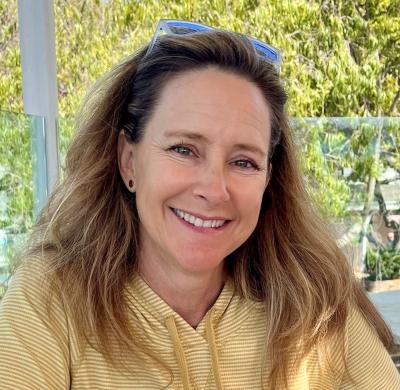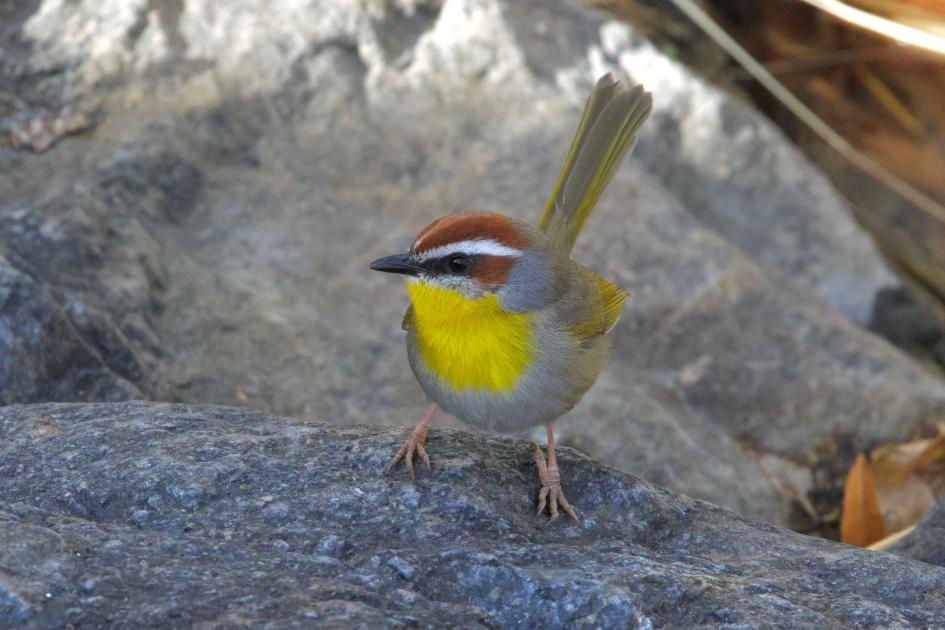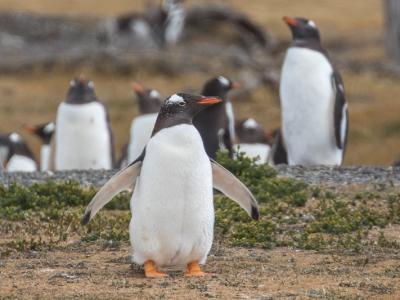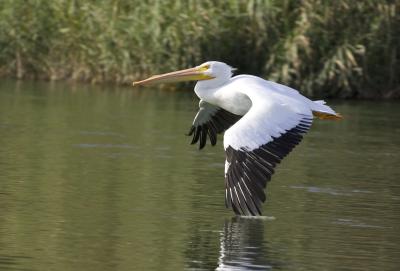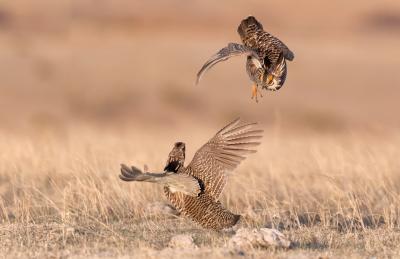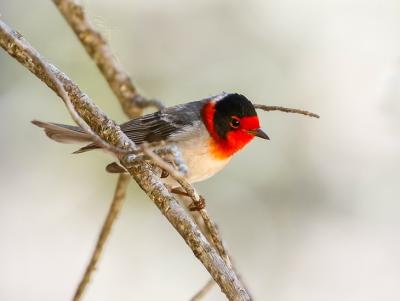Arizona: A Winter Week in the Southeast
-
Jan 25 to Feb 1 2026
Jake Mohlmann
-
Jan - Feb, 2027
Jake Mohlmann
2026
Single Room Supplement $850
2027
Tour Price to be Determined
2026
Single Room Supplement $850
2027
Tour Price to be Determined
This short tour covers a slice of southeastern Arizona at a time when bird populations are high—in some cases spectacularly high. We’ll visit imposing mountains, desolate canyons, vast grasslands, desert lakes and streams, and a few favored human-made sites. We’ll look for the area’s specialized avifauna, search for rarities along our route, and talk about what we’re seeing.
Other than our bookend nights in Tucson, we’ll stay at the charming Casa de San Pedro, a beautiful place with perfect night skies and birds just outside the door.
Day 1: The tour begins this evening in Tucson. Night in Tucson.
Day 2: We’ll depart to the south for Madera Canyon, stopping in desert on the way to look for Rufous-winged and tinkling Black-throated Sparrows. Once in Madera, we’ll be met in the lower canyon’s oaks by Arizona Woodpecker, the gregarious Mexican Jay, Bridled Titmice, perhaps a stunning Painted Redstart, and if we’re very lucky, an Elegant Trogon. Later we’ll continue east through Box Canyon and emerge in rolling grasslands, where perhaps we’ll see Chihuahuan Meadowlark fleeing from roadside fences.
We’ll pass through Sonoita in the heart of Arizona’s wine country, where various sparrows and raptors exploit the vast open lands, and continue east toward the north-flowing San Pedro River and Casa de San Pedro, our very comfortable home for the next five nights and a superb place to come back to after a day in the field. Night at Casa de San Pedro near Sierra Vista.
Days 3–6: From our base at Casa de San Pedro, we’ll fan out in all directions, letting weather and circumstances determine each day’s destination. In general we’ll work from the farthest spot west, in and around Patagonia, and continue a bit farther east every day until we end up in the celebrated Chiricahua Mountains.
We’ll visit Patagonia Lake State Park, where winter birds include Gray, Hammond’s, and Dusky Flycatchers, and with great good luck Black-capped Gnatcatcher, a species that has occurred here in very low numbers in recent years. We’ll also visit feeders in Patagonia proper, where the striking Violet-crowned Hummingbird often winters and Lazuli Bunting adds electric blue to the color palette. The Patagonia city park with its large trees, often ripe with fruit, can harbor interesting wintering species such as rare sapsuckers or Hepatic Tanager.
We’ll explore the Huachuca Mountains and the San Pedro River drainage. What we do here will depend on weather and to some extent on what we’ve seen during the tour’s first days. Several wonderful canyons on the eastern slopes of the Huachucas can hold tooting Northern Pygmy Owl or Montezuma Quail, and the San Pedro River sometimes has a resident Green Kingfisher, often detected by its softly penetrating call, like two stones tapped together.
We’ll spend a day in the Sulphur Springs Valley where we’ll witness at Whitewater Draw Wildlife Area the mass arrival of thousands of Sandhill Cranes from their morning’s foraging. At its best, it’s a spectacular, occasionally deafening experience as multitudes of birds return from feeding on waste corn and other crops in the valley. In addition to the cranes, Whitewater Draw holds a mix of other waterbirds, often including a shimmering cloud of Snow and Ross’s Geese.
The primitive appeal of large birds in such high numbers is undeniable, but for some the real attraction of the Sulphur Springs Valley is the mass of sparrows, buntings, and raptors that are drawn to all the food that this typically well-watered valley can provide. It’s never quite the same from one year to the next, but the regal Ferruginous Hawk is regular and Red-tailed Hawk in all its bewildering variation is abundant. If it’s a good seed year, waves of White-crowned and Brewer’s Sparrows pour over the landscape and the soft, whistled “whew” of Lark Bunting is everywhere. Among the less common denizens we may encounter are Mountain Plover, buffy-faced Bendire’s and streaky Sage Thrashers, or perhaps Thick-billed Longspur.
No trip to southeast Arizona would be complete without a visit to Portal at the mouth of spectacular Cave Creek Canyon in the heart of the mighty Chiricahua Mountains. Several types of habitats converge in this area and the bird diversity reflects this. In the big thickets just outside town we’ll look for the very shy Crissal Thrasher, the recently split Woodhouse’s Scrub-Jay, and spry Black-tailed Gnatcatcher. Portal proper has numerous feeder arrays and we’ll hope to see Rivoli’s Hummingbird and Blue-throated Mountain-gems, both distinct possibilities at this time of year. If road conditions allow, we’ll drive into the higher reaches of the mountain range where we have a chance to cross paths with Mexican Chickadee, in the only place north of Mexico one can see this range-restricted species. Nights at Casa de San Pedro.
Day 7: After our last delicious breakfast at Casa de San Pedro, we’ll return to Tucson. This desert city is a magnet for wintering birds, usually including something rare. We’ll take time to visit parks and lakes scattered throughout the Tucson Valley, searching for stakeouts and resident Sonoran Desert species we may have missed. We’ll finish with an afternoon stroll around Tucson’s Sweetwater Wetlands, a wonderfully accessible collection of ponds and scrub that can hold hundreds of ducks and a variety of wintering passerines. As the afternoon fades and dusk sets in, numbers of blackbirds, including male Yellow-headed, come in to overnight in the reed beds. Night in Tucson.
Day 8: The tour concludes this morning in Tucson.
Note: The information presented below has been extracted from our formal General Information for this tour. It covers topics we feel potential registrants may wish to consider before booking space. The complete General Information for this tour will be sent to all tour registrants and of course supplemental information, if needed, is available from the WINGS office.
ENTERING THE UNITED STATES: Non-U.S. citizens will need a valid passport and may need a tourist visa. Consult your nearest U.S. Consulate for details.
Canadian citizens should carry proof of citizenship in the form of a passport. Please note that non-US citizens are required by law to carry passports/visas with them at all times.
U.S. citizens should bring their driver’s license, birth certificate and/or passport.
PACE OF THE TOUR: Under normal circumstances no major hiking is required but on occasion, depending on what birds are visiting for the winter and the group’s abilities, we may attempt some brief rock scrambling. A hike of up to 3/4 mile into a mountain canyon with elevation gains upwards of 500 feet may be possible. The longest walk on the tour would be 1-2 miles at an easy pace on level ground through the grasslands looking for various birds.
HEALTH: Arizona presents no real hazards to the visiting bird-watcher but certain factors must be considered.
Elevation: In Tucson we will be staying at 2,600 feet and while in Sierra Vista our hotel is at an elevation of 4,250 feet. If there is no snow on the mountains we may go birding up to 8,000 feet. While at this elevation foot travel will be limited to walking less than ¼ mile from the vehicle.
Sun: Winter sun is powerful and deserves respect. Please bring and use sunscreen as well as a broad-brimmed hat.
Spiny Plants: The most common injury results from spines penetrating light-weight canvas shoes though the sides and soles. Many desert plants are armed with thorns or spines, and native grass seeds can be a nuisance.We recommend tough canvas or leather shoes of at least ankle height and tough trousers as the best safeguards.
Dehydration: Dehydration is a constant concern in Arizona especially when birding at lower elevations in the desert. Drinking a lot of water is highly encouraged throughout the tour. The leader will always have an ample supply of water in our vehicle and make frequent pit stops along the way to use the bathroom facilities.
Smoking: We request that you do not smoke in the vehicles or when the group is gathered for meals, checklists, etc. If you are sharing a room with a non-smoker, please do not smoke in the room. If you smoke in the field, we ask that you do so well away and downwind from the group. If any lodge, accommodation or location where the group is staying or is gathered has a more restrictive smoking policy than WINGS’ policy, the more restrictive policy will prevail.
CLIMATE: In winter (November to February), daytime highs are in the 60-70° range with nighttime lows in the 30s and 40s F. It can be colder at high elevations and it is always possible to experience days with maximum temperatures of 10°F above or below these figures. Be prepared for early morning temperatures below freezing, sometimes in the single digit temps. Rain is infrequent but periodic storms can produce precipitation throughout. Snow is regular above 6000 feet and as low as 3000 feet.
ACCOMMODATIONS: We stay at a standard motel in Tucson near the Tucson Airport, but elsewhere our lodging is of an unusually high standard. Casa de San Pedro Bed & Breakfast (http://bedandbirds.com/) sits on ten acres adjacent to the San Pedro River and Riparian National Conservation Area on the eastern edge of the Huachuca Mountains.
Wireless internet is available in all places we stay.
FOOD: Breakfasts and several catered dinners will be at Casa de San Pedro. We may have some picnic lunches but winter weather is unpredictable. Sit-down meals will be at local restaurants with standard American food.
Food Allergies / Requirements: We cannot guarantee that all food allergies can be accommodated at every destination. Participants with significant food allergies or special dietary requirements should bring appropriate foods with them for those times when their needs cannot be met. Announced meal times are always approximate depending on how the day unfolds. Participants who need to eat according to a fixed schedule should bring supplemental food. Please contact the WINGS office if you have any questions.
TRANSPORTATION: We will be traveling by leader-driven 12 or 15 passenger window van or minivan, depending on the group size. Participants should be able to ride in any seat in tour vehicles. A daily seating rotation will be expected in the vehicles.
2025 Narrative
In Brief:
We just wrapped up another Winter Week in Arizona tour filled with beautiful scenery and abundant wildlife. This year 142 species of birds were encountered as we traversed just under 1,000 miles of mostly paved roads. Every day of our tour visited a very unique area of southeast Arizona, each worthy of day’s exploration. Rufous-capped Warbler, Arizona Woodpeckers, and Painted Redstarts met is in the mid-elevation canyons. Sparrows abound in the grasslands as we spent several days enjoying Lark, Vesper, Brewer’s as well as fleeting flocks of Lark Buntings. We saw several local specialties including Greater Pewee, Mexican Chickadee, Rufous-backed Robins and a particularly confiding male Elegant Trogon. Hummingbirds were in good supply with both of the giants Rivoli’s and Blue-throated Mountain-gem seen well, as well as an eye-catching Violet-crowned in Ramsey Canyon. The incredible Sandhill Crane show in the Sulphur Springs Valley is an event we’ll never forget. Spending 5 nights in one place meant less time packing and moving, and more time enjoying a place we could call our home away from home for the entire week.
In Detail:
First thing in the morning we checked some agricultural fields on the outskirts of town. Several rufous-morph Red-tailed Hawks were adorning poles, as well as an adult Cooper’s Hawk sporting its obvious dark cap. Huge flocks of Great-tailed Grackles and Red-winged Blackbirds were emerging in streams leaving the nearby marshes after roosting there for the night. A Say’s Phoebe whistled its presence and perched on a fence while a Verdin’s face glowed in the first sun rays of the day. Further south in Tubac we were treated to an eyeful when eventually we tracked down a couple coveted Rufous-backed Robins that had taken up shop at some fruiting hackberry trees along the Santa Cruz River. Other familiar species seen here first included a woodpecker party including Gila, Ladder-backed, and “Red-shafted” Northern Flickers. White-winged Doves were in full song, making us wonder if spring was already underway. A pair of Western Bluebirds glowed in the sun as they sat in the scope for prolonged views. Along the I-19 corridor we stopped at a reclaimed water pond where there was a good showing of rare waterfowl. We sifted through the Bufflehead and Ring-necked Ducks to pick out both Hooded and Red-breasted Mergansers diving frequently. A nice comparison of Lesser and Greater Scaup ensued, noting head shape and bill nail differences. It took us a while, but eventually we spotted the Ross’s Goose we were looking for. It had been there the entire time unbeknownst to us, sitting perfectly hidden on one of the aerators. It stood up long enough for us to observe the small triangle bill and lack of grin patch nicely. Up into Madera Canyon we had a lovely picnic lunch surrounded by some wonderful birds. In constant patrol of stray morsels were a group of bright blue Mexican Jays, and the Arizona Gray Squirrels were being quite bold. A Painted Redstart was followed as it foraged through the oak and juniper trees, flashing its white wing and tail patches trying to flush up its unique prey. Along the creek we ran into a flock or two, each containing some special birds of the region. Bridled Titmouse turned into one of our favorites as we admired the striking black and white facial pattern and cute little crest. Joining them were Hutton’s Vireos giving a good lesson in separating them from the similar-looking Ruby-crowned Kinglets. A Brown Creeper had no fear as it snuck up a white-barked sycamore tree making it obvious to pick out the moving brown dot against the pale background. Another Painted Redstart came in to the same tree allowing much better looks this time around while it fed on fleeting prey. A light tapping sound brought our attention to an Arizona Woodpecker going to town on an insect-laden snag at eye level allowing a photographic frenzy from all. Overhead White-throated Swifts were reeling around likely coming in to grab a drink from the scarce water source the stream here has to offer. At the Santa Rita Lodge the giant Rivoli’s Hummingbird was enjoyed. Several were chasing each other around the grounds like fighter jets. It was crazy to us how large these birds were, initially not realizing they were even hummingbirds due to their large stature. On the ground Wild Turkeys scuffed through the fallen seeds dropped by the Lesser Goldfinches above. It was also nice to see the glowing eyes of the Yellow-eyed Juncos beaming in the shade, compared to the coal-colored eyes of the “Gray-headed” Dark-eyed Juncos feeding next to them. We made our way east through Box Canyon and stopped to check out a field full of Brewer’s Blackbirds. The males were gleaming in the sun with a black sheen to their plumage and had some nice bright yellow eyes.
The next day we traveled to the Patagonia area. In the town park the Western Bluebirds were having a feast on Chinese pistache berries. In the mix we were lucky to spot an Eastern “Azure” Bluebird adorned with orange throat and white belly. Oddly, a Vesper Sparrow came in and perched silently in the same tree, sitting still for extended scope views. Not a usual behavior for this normally fleeting species. Across the road a Cedar Waxwing sat motionless. If it wasn’t such a colorful bird, it may have gone unnoticed. Along Harshaw Creek the water was flowing, giving a much-needed resource to the parched landscape. Canyon Towhees were well-represented with several scratching through the leaves along the road. A Gray Flycatcher gave us a great show as we observed its unique behavior of bobbing its tail downward when perched. The group was also able to track down a Red-naped Sapsucker we had heard that ended up being right over their heads at the end! Also, yet another Painted Redstart here was a crowd pleaser. As we were heading back into town a group of Black Vultures took off from a towering tree. The short, broad tail was noted, as well as snappy wingbeats and silvery-tipped wings. At the Paton Hummingbird Center the brush piles were hopping with activity. Well over 100 White-crowned Sparrows were constantly shooting in and out of the cover. At one point a Sharp-shinned Hawk landed in the middle and all at once everything shut down. It didn’t take long after the bird left for activity to pick back up again. Bewick’s Wrens were slowly working their way through the shrubs, as well as several Song Sparrows of the southwestern race. We appreciated the chance to have great comparison views of both Northern Cardinal and Pyrrhuloxia sitting right next to each other, showing differences in shades of red, crest size, and bill color and shape. Our next stop was Patagonia Lake State Park where we had a lovely picnic while overlooking the deeper water by the dam. Initially we noticed a single gull way out there that turned out to be a Ring-billed Gull, the only gull we saw the entire week. It didn’t take long to spot a pair of loons at a distance. The Common Loon, with bigger, blockier head and larger body seemed to dwarf the Red-throated Loon swimming next to it with paler body and slightly upturned head. Any loon in the desert is a rare sighting, so we were excited to see two different species at once. A small flock of Eared Grebes was floating out near some buoys, and a Double-crested Cormorant was using one of the buoys to dry its outstretched wings. Along the birding trail we strolled along the cottonwood-lined shore of the lake. At the feeders a striking Black-throated Sparrow popped up into a gray thorn and sat nicely for us. We remarked how good looking this bird was with white facial lines and pitch-black throat. Scratching around on the ground was another handsome sparrow. A Green-tailed Towhee showed how it had much more than just its green tail to be proud of. Some large diving ducks out on the lake caught our attention. A group of green-headed bright white male Common Merganser took turns diving in the shallower end of the lake. There was a tree-full of Neotropic Cormorants on the lake’s edge, looking like ornaments neatly adorned on each branch. In one of the mesquite bosques down below we tracked down a delightful Cassin’s Vireo working through the branches overhead. Some Lincoln’s Sparrows were hopping in and out of the grass clumps, and Bewick’s Wrens were working the bark of the Gooding’s Willow trees. Hermit Thrushes were in good supply, each taking time to pick through the fallen hackberries littering the understory.
The University of Arizona was banding birds at the Casa the next morning. They are doing a study of avian ticks and the transmission of disease from them to humans. This gave us a unique opportunity to see some birds in the hand. We took in the finer details of a first year Pyrrhuloxia and studied the fat score of a White-crowned Sparrow. The world-famous Sulphur Springs Valley was furnished with abundant Sandhill Cranes and teemed with raptors. While searching for a fleeting thrasher along Coffman Road, we were happily distracted by a perched Chihuahuan Meadowlark displaying its white throat and dark head lines well. Our attention was averted when some chicken-like birds scurried across the yard of a nearby house. These Scaled Quail were running single file to a barrel full of water put out by the homeowner. This resource proved to be extremely valuable in this arid area as other birds joined for a drink. Thousands of cranes began flying in mid-day as wave after wave of gray lines filled the sky. Whitewater Draw had perfect light for photographs as the group enjoyed several duck species whose males were particularly zesty including Green-winged Teal, Northern Pintail, and American Wigeon. A shimmering group of Snow Geese littered the shore, while a few American Pipits worked the water’s edge. As we were strolling along the berm a small pale bird hopped into view only a few feet away. It was a Rock Wren that was practically taking us for a walk checking for morsels in the cracks of the embankment. It was nice to see this bird so well after chasing one around and seeing it at a distance earlier in the morning. Savannah Sparrows were perching on twigs at close-range in the marsh, but a male Lazuli Bunting took the cake with neon blue head and orange chest. While getting extremely close looks at Mexican Ducks hiding in some of the loafing cranes, we saw a bullet with wings flash by us that turned out to be a Merlin in hot pursuit. It shot out over the grassland and nearly smashed into a hunting harrier. Lucky for the Merlin at that moment a bird shot up from the grass scared by the harrier, so it immediately snatched it up and continued to perch on the nearest tree to consume it. While scoping this scene, we noticed a Greater Roadrunner hopping up through the middle of the tree towards to Merlin. It appeared to us that the roadrunner was trying to steal the quarry the Merlin had just captured. An unreal behavior to witness! While scoping here we noticed a concealed Great Horned Owl expertly camouflaged in the willow trees blending in perfectly with the tree trunks. Just before leaving we spied a Wilson’s Snipe allowing close approach while sticking its bill deep into the mud.
After we left the draw, we set out into the surrounding environs. From one spot we were able to encounter the next 5 target birds. At one of the agricultural fields nearby we stopped to scan when we noticed a Killdeer standing alone in the middle. Much to our surprise, there ended up being two highly sought after Mountain Plovers out there with it. Scanning the irrigation machines here yielded a perched light-morph Ferruginous Hawk. While soaking in the hawk, we noticed some blue flashes flitting across the turf. These turned out to be a group of male and female Mountain Bluebirds. On the other side of the road in the mesquite grasslands a bird was perched up in a tree that quickly revealed itself to be a Bendire’s Thrasher. A quick check of the transmission pole line down the road yielded a Prairie Falcon that had been there watching us the whole time. This was an unreal sequence of events. To end the excitement a dark-morph Ferruginous Hawk took its time soaring in circles overhead. Just when we thought the day couldn’t get any better after the crane show, this happened. Further up the valley we spotted two more Ferruginous Hawks hunting over cut alfalfa fields. We drove down the nearest road and, although we never found the hawks any closer, another raptor highlight occurred. We slowly crept up in the van and managed to park right under a stunning Prairie Falcon. It was comfortable enough we were able to go down the road, turn the van around, and have the other side of the van experience this very hospitable bird of prey. As we were pulling away, we noticed a huge pile of feathers just down the road. The remains of a Eurasian Collared-Dove was blowing in the wind and we surmised this large meal was the reason for the falcon being so content with where it sat. This evening we made an effort to try for owls near our accommodation. We succeeded in hearing the deep hoots of a female Great Horned Owl that came closer and closer, eventually flying right over our heads.
After our delicious homemade breakfast, we took a walk around the grounds of the casa where Pyrrhuloxia and Northern Cardinals were once again gorging on the generous feed supply. A family of Cactus Wrens popped out of a huge yucca complex at the corner of the building and soaked in the fun watching over the morning’s antics. White-crowned and Song Sparrows were coming into the mostly frozen pond. The only open water was being kept open by an electric aerator and the birds greatly appreciated it. We strolled through the grasslands of the San Pedro River National Conservation Area and were greeted with many more sparrows. Vesper Sparrows were the most abundant flitting from the sides of the trails. Tied for second were equal parts Lincoln’s and Savannah Sparrows. Small groups of Brewer’s Sparrows were also in constant supply. It was great having all these species together for a great sparrow ID field lesson. One last look at the feeders had a nice surprise when a White-throated Sparrow popped into view. We all learned why they named it that! At the nearby San Pedro House the feeders were hopping with activity. A unisex flock of female Red-winged Blackbirds were gorging on seed, and White-winged Doves were sitting in all the trees above. A flock of Lesser Goldfinch came in to get a bath. While we were picking through the scads of White-crowned Sparrow we eventually noticed a very rare Harris’s Sparrow that had been rumored to be in the area. After enjoying our fortune cookies, we took our locally made sandwiches up into Ramsey Canyon to eat while being serenaded by mid-elevation species once again. Our main target here was Violet-crowned Hummingbird. It only took us about 10 minutes before one of these clean-fronted purple-crowned beauties graced our binocular views and proved why once again this is a highlight hummer for the trip. The area also provided us another look at Arizona Woodpecker, Rivoli’s Hummingbird, and a group of Wild Turkeys. The ground at the Cabins had over 80 bird feeders, most of which we had a good look at. We even added Inca Dove to our list here, noting the scaled pattern of the plumage diagnostic to this species. Before calling it a day, we drove up to Montezuma Pass in the Coronado National Monument to get a good look at the border barrier situation. Far off to the west there was nothing but gently rolling hills and oak-studded grasslands, but to the east there were 52 miles of contiguous fence straight out across the land. What a contrast in landscapes.
No trip to southeast Arizona would be complete without a visit to Portal at the mouth of the mighty Cave Creek Canyon. En route we stopped roadside to catch the finer details of what made a large black bird a Chihuahuan Raven and not the more abundant Common. We made a brief stop at a museum that hosts a riparian exhibit and a particularly good souvenir shop with just about any animal from the region possible to get on a hat. As soon as we walked into the riparian zone a complete surprise Bendire’s Thrasher was sitting up in one of the few leafless trees in the courtyard. It was great improving our looks at this specialty, and also nice to see a similar Curve-billed Thrasher in quick succession for a nice comparison of bill shapes. A brief visit to a private residence in the Big Thicket allowed close looks of the (normally) skulky Crissal Thrasher that sat up for several minutes allowing ample viewing pleasure for all. The largest hummingbird in the country, the colossal Blue-throated Mountain-gem, was seen exceedingly well at Cave Creek Ranch. Pine Siskins joined the more numerous Lesser Goldfinches at the feeders, and a very bold Bridled Titmouse came in for meal worms at an arm’s length. Some fruiting hackberry trees on the property had flocks of American Robins taking advantage of the food source, as well as groups of high-pitched calling Cedar Waxwings. After our stunningly beautiful lunch spot under towering cliffs, we made our way up along Cave Creek. The lichen-covered pink rocks began to show themselves as we climbed up above the 7000’ mark searching for some of the montane species. The views from this vantage are beyond belief staring down the heart of this massive craggy mountain range. In the pine zone snow prevented us from going any higher than Turkey Creek. Lucky for us, a stroll down the snowy two-track next to the creek finally found us right in the middle of a foraging flock that contained at least two Mexican Chickadees, a huge prize for any North American birder! Also in this area was a Hairy Woodpecker keeping a beat, Spotted Towhee scratching in the grit, and querulous flock of noisy Bushtits in constant motion. After our successful chickadee journey, we headed back down the mountain and back into Cave Creek Canyon. Some roadside calls got the van to pull over and we spotted a group of Steller’s Jays traveling through the tops of the pine trees. Also here a Chiricahua Fox Squirrel caught our attention while watching the Jays. This subspecies of Mexican Fox Squirrel is endemic to the Chiricahua Mountain Range. We ended our birding day with a walk down Main St. in Portal. This was a peaceful way to end the day, with even more Blue-throated Mountain-gems catching insects in the conifers, Inca Doves singing the ‘hopeless’ songs, and a couple Red-naped Sapsuckers defending wintering territories. As we were waiting for our food to come at dinner, a flock of Gambel’s Quail landed just outside the window of the restaurant. We rushed out to get great looks at these intricately designed birds with black top feathers as they made their way to their roosts for the night.
Our last day is always exciting as we meander through the various habitats back to Tucson trying to fill in the checklist with species we haven’t seen up to this point. We first checked out Las Cienegas National Conservation area and its gently rolling grasslands bookmarked by several scenic mountain ranges. At Davis Pasture we tried our luck at finding longspurs. A dry rattle call alerted us that there was a few of them in with a roving flock of Horned Larks. We soon picked out a couple gorgeous Thick-billed Longspurs feeding atop the dusty ground. These individuals allowed really good scope views, giving the chance to examine their black chest bands and rusty shoulders nicely. Then we headed back through the scenic Box Canyon, but this time to Florida Canyon. This is a famous drainage for breeding Rufous-capped Warblers, and as luck would have it one of these birds decided to spend the winter here. We hiked up the rocky path taking in the scenery and within a minute of arriving to the area the warbler had been, it popped out right into view and everyone got great looks. This is not an easy task with this warbler that usually sticks to the densest thickets where it hides quite well. Then we headed over to Madera where we would try once again for a trogon that was hanging out in the canyon. There were many people in the canyon doing the same thing and eventually we were tipped off that the bird was being seen about 15 minutes up the trail. We rushed, some more than others, to the location and were rewarded with a lengthy look at male Elegant Trogon as it repeatedly sallied for berries on the trees. Finally, success with perhaps our most-wanted bird of the trip. We went up canyon a bit more afterwards and as soon as we got out of the van we heard the ‘pip-pip-pip’ calls of a Greater Pewee. The looks were amazing as we got the bird in the scope and watched it fly catch from the tops of the tallest sycamore trees. Down in Green Valley we stopped at Desert Meadows Park where multiple male Broad-billed and Costa’s Hummingbirds sang to us with their unique voices, perching long enough to see all their shiny parts glowing in the sun. At a nearby church, we sat in our van and watched as birds were trickling in to get a drink from a fountain seemingly in the middle of nowhere. Ultimately our target here showed up as we watched a few Lawrence’s Goldfinches stage to come in showing overall gray plumages and yellow highlights in their wings. We were running out of daylight, but we made one more stop at a nearby park to find our last bird of the trip. A male Vermilion Flycatcher was our goal. Not only did we find one, but were able to walk right up to it and get great photos of it as it dropped from a chain link fence repeatedly to the ground scooping up insects.
Many people were surprised by the varied habitat and bird diversity offered on this tour. While the rest of the country was being overwhelmed with winter weather, sunny southeast Arizona provided its usual warm temperatures, clear skies, and abundant bird life. Throughout the week there was a nice mix of regional southeast Arizona specialties, lots of expected wintering wanderers, and even a few of the rarest species in the country at this time. The group got along amazingly well this year, allowing for an easy pace and lots of delightful conversations throughout the days. All this proved once again why this tour is so much fun and a must for anyone looking for a break from the winter doldrums experienced elsewhere in the country this time of year.
- Jake Mohlmann 2025
I have been on numerous group tours both with WINGS and others. This tour with Jake ranks very near if not AT THE TOP. Jake is a perfect guide, knowledgeable about birds and related topics. He is patient making sure that the birders have good looks etc. He is also a good and careful driver . The seven participants meshed well and the accommodations and meals excellent. I loved that most lunches were picnics.
- Claude B. on Arizona: A Winter Week in the Southeast
Jake is a real gem, an ideal leader - always knowledgeable, pleasant and personable.
- Judy G. on Arizona: A Winter Week in the Southeast
Jake is simply the best guide you could have. His love of birds is obvious and his knowledge of SE Arizona is so impressive. The other birders were so supportive and helpful. It was my first birding vacation and it couldn't have been more perfect. I wish I could go on each and every one of the Wings tours.
- Jen K. on Arizona: A Winter Week in the Southeast
Everything was perfect. Jake is a superb leader with tremendous birding skills as well as great people skills. The B&B was comfortable and charming, and the food ws fantastic. Even the birds put on a show, and Jake had us in a perfect place to watch.
- MaryAnn T. on Arizona: A Winter Week in the Southeast
Jake was a great guide for my first birding experience. He knows how to find birds. He recognizes the bird calls and was uncannily accurate in identifying the birds we were seeing....He also researched the local bird sightings and had an identified agenda each morning which helped ensure we saw a wide variety of birds. As a beginner, he was patient with me when I had to ask novice questions or required a bit of extra assistance to either sight the bird or identify the bird I was viewing.
- John K. on Arizona: A Winter Week in the Southeast
Maximum group size seven with one leader.














































